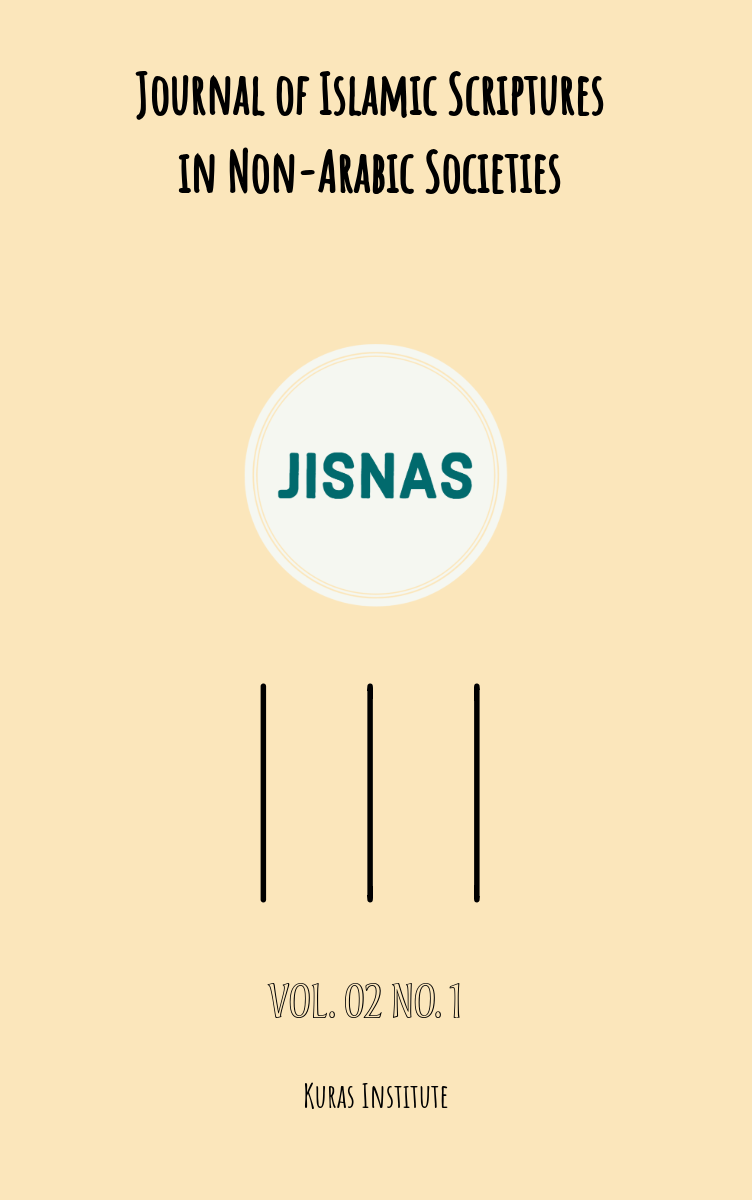Pandangan Al-Qur’an Terhadap Hoaks Persepektif Tafsir Maqāṣidī (Studi Q.S. Al-Ḥujurāt: 6 dan al-Nūr: 15)
Abstract
The phenomenon of hoax dissemination in the digital era has become a serious challenge with far-reaching impacts on social stability, political dynamics, and religious life among Muslim communities. The Qur’an, as the holy scripture of Islam, offers fundamental principles for responding to information, particularly through verses that emphasize verification and caution, such as Q.S. al-Ḥujurāt [49]:6 and Q.S. al-Nūr [24]:15. This study aims to analyze the content of these two verses using the maqāṣidī tafsir approach as developed by Abdul Mustaqim, in order to uncover the substantial and contextual values of Islamic law. This research employs a qualitative method with a descriptive-analytical approach based on literature review from primary and secondary authoritative tafsir sources. The findings reveal that these verses encompass core values of maqāṣid al-sharī‘ah, including: ḥifẓ al-nafs (protection of life), ḥifẓ al-‘aql (protection of intellect), ḥifẓ al-dīn (protection of religion), ḥifẓ al-dawlah (protection of the state), and ḥurriyyah al-mas’ūliyyah (responsible freedom). These values are not only normative but also practical in addressing the challenges of modern disinformation. Thus, the maqāṣidī approach presents a relevant and solution-oriented methodology for shaping ethical media engagement and fostering responsible Islamic digital literacy in contemporary society.
References
Al-Mubarakfuri, Shafiyyurrahman. Shahih Tafsir Ibnu Katsir JIlid 3. bogor: pustaka ibnu katsir, 2009. Google.
Amrullah, Abdulmalik karim. Tafsir Al-Azhar. jilid 6. Singapura: Pustaka Nasional PTE LTD Singapura, 2019.Google.
Ashshiddiqi, Muhammad Thaef. “Hoax Dalam Al-Qur’an.” Skripsi, Universitas Islam Negeri Sumatera Utara, 2019. http://repository.uinsu.ac.id/6847/.
Bennett, W Lance, dan Steven Livingston. “The Disinformation Order: Disruptive Communication and the Decline of Democratic Institutions.” European Journal of Communication 33, no. 2 (1 April 2018): 122–39. https://doi.org/10.1177/0267323118760317.
Chasbullah, Arif Chasbullah, dan Wahyudi Wahyudi. “Deradikalisasi Terhadap Penafsiran Ayat-Ayat Qital.” Fikri: Jurnal Kajian Agama, Sosial dan Budaya 2, no. 2 (Desember 2017): 407–24. https://doi.org/10.25217/jf.v2i2.165
Edy M Yakub. “Indonesia dan Hoax, Perang Digital, Israel Palestina.” antaranews.com, t.t.
Faizah, Nur. “Konsep Laktasi Dalam Al-Qur’an Perspektif Tafsir Maqāṣidī.” Diploma, IAIN Ponorogo, 2022. https://etheses.iainponorogo.ac.id/18802/.
H.A.A Dhahlan K.H.Q Shaleh dan dkk. Asbabun Nuzul( latar belakang historis turunya al-Qur’an). Bandung: CV Penerbit Diponegoro, t.t. google.
Haleem, M.A.S. Abdel. “The Role of Context in Interpreting and Translating the Qur’an.” Journal of Qur’anic Studies 20, no. 1 (1 Februari 2018): 47–66. https://doi.org/10.3366/jqs.2018.0320.
Idris, Ika Karlina. “Government Social Media in Indonesia: Just Another Information Dissemination Tool.” Jurnal Komunikasi: Malaysian Journal of Communication 34, no. 4 (2018): 337–56. https://doi.org/10.17576/JKMJC-2018-3404-20.
Januarti, Nur, Heru Nugroho, dan Arie Sujito. “Negotiation and compromise in online learning during the Covid-19 pandemic.” Informasi 53, no. 1 (31 Desember 2023): 93–106. https://doi.org/10.21831/informasi.v53i1.61339.
Junaidi, Juliyana, Latifah Abdul Majid, dan Mohd Arif Nazri. “Revisiting Social Justice: Exploring the Qur’anic Paradigm in Addressing Contemporary Challenges.” Afkar: Jurnal Akidah Dan Pemikiran Islam 25, no. 2 (28 Desember 2023): 153–92. https://doi.org/10.22452/afkar.vol25no2.5.
“Maqashid Al-Sharia in the Study of Hadith and Its Implication for the Renewal of Islamic Law: Study on Jasser Auda’s Thought | Justicia Islamica.” Justicia Islamica: Jurnal Kajian Hukum Dan Sosial 19, no. 1 (2022). https://jurnal.iainponorogo.ac.id/index.php/justicia/article/view/3269.
Meel, Priyanka, dan Dinesh Kumar Vishwakarma. “Fake news, rumor, information pollution in social media and web: A contemporary survey of state-of-the-arts, challenges and opportunities.” Expert Systems with Applications 153 (1 September 2020): 112986. https://doi.org/10.1016/j.eswa.2019.112986.
Misbah, M.Quraysh. “Tafsir Al-Misbah jilid 9.” Lentera Hati, 2001. google.
Munandar, Siswoyo Aris, dan Saifuddin Amin. “Contemporary Interpretation Of Religious Moderation In The Qur’an: Thought Analysis Quraish Shihab And Its Relevance In The Indonesian Context.” QiST: Journal of Quran and Tafseer Studies 2, no. 3 (22 Agustus 2023): 290–309. https://doi.org/10.23917/qist.v2i3.1448.
“qur’an kemenag - Penelusuran Google.” Diakses 8 Desember 2023. Https://Www.Google.Com/Search?Q=Qur%27an+Kemenag&Oq=&Gs_Lcrp=Egzjahjvbwuqcqgaecmyjxjqajijcaaqixgngoocmgkiarajgccy6giycqgcecmyjxjqajijcamqixgngoocmgkibbajgccy6giycqgfecmyjxjqajijcayqixgngoocmgkibxajgccy6glsaq05otawotcyndnqmgo3qaiisaib&Sourceid=Chrome&Ie=UTF-8.
Sabila, Dzilan, dan Aulia Rezki. “The Relationship Between Social Structure Andreligiouspractice In The Context Of Qur’anic Studies Implications For Social Science Studies.” International Journal Multidisciplines and The Development of Science 1, no. 3 (16 Desember 2024): 274–83. https://jurnal.asrypersadaquality.com/index.php/ijmds/article/view/485.
Saputri, Ika. Hoax Dalam Persepektif Al-Qur’an (Studi Kisah Dalam Surat Yusuf [12]: 4-18 Dengan Pendekatan Semiotika Charles Sanders Pierce) | Universitas Ma`Arif Lampung. Metro: Umala, 2021. //digilib.umala.ac.id%2Findex.php%3Fp%3Dshow_detail%26id%3D34914%26keywords%3D.
Shihab, Muhammad Quraish. Tafsir Al-Misbah. Vol. 13. Tangerang: Lentera Hati, 2001. google.
Team, Almaany. “Terjemahan Dan Arti Kata فتبينوا Dalam Bahasa Indonesia, Kamus Istilah Bahasa Indonesia Bahasa Arab Halaman.” Diakses 9 Mei 2024. https://www.almaany.com/id/dict/ar-id/%d9%81%d8%aa%d8%a8%d9%8a%d9%86%d9%88%d8%a7/.
———. “Terjemahan Dan Arti Kata نبإ Dalam Bahasa Indonesia, Kamus Istilah Bahasa Indonesia Bahasa Arab Halaman.” Diakses 9 Mei 2024. https://www.almaany.com/id/dict/ar-id/%D9%86%D8%A8%D8%A5/.
“Terjemah Tafsir Al Munir - 9.pdf.” Diakses 9 Mei 2024. https://ia904603.us.archive.org/8/items/terjemah-tafsir-al-munir-mktbhazzaen/Terjemah%20Tafsir%20Al%20Munir%20-%209.pdf.
Yakhsyallah, Yakhsyallah. “Bahaya Penyebaran Hoaks: Studi Kasus QS. Al-Nūr [24]: 11 Dan QS. Al-Ḥujurāt [49]: 6.” Ulil Albab : Jurnal Ilmiah Multidisiplin 2, no. 12 (27 November 2023): 5796–5807. https://doi.org/10.56799/jim.v2i12.2508.
Zaini, Zaini. “Antisapasi Hoax Di Era Informasi: Pendidikan Karakter Perspektif Al-Qurán Surah Al-Hujurat Ayat 6: Antisapasi Hoax Di Era Informasi: Pendidikan Karakter Perspektif Al-Qurán Surah Al-Hujurat Ayat 6.” Ngaji: Jurnal Pendidikan Islam 1, no. 1 (1 Maret 2021): 1–24. http://ngaji.or.id/index.php/ngaji/article/view/5.
Zuhaili, Wahbah. Tafsir Al-Munir jilid 2. Jakarta: Gema Insani, 2013. google.
Zulliandi, Yuviandze Bafri. “The Transformation of Qur’an Interpretation and The Dynamics of Text Authority in Indonesia:” Jadid: Journal of Quranic Studies and Islamic Communication 4, no. 02 (9 Desember 2024): 107–37. https://doi.org/10.33754/jadid.v4i02.1285.



